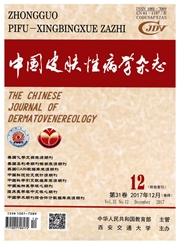

 中文摘要:
中文摘要:
目的测定耐氟康唑白念珠菌对常见抗真菌药物的敏感性,并探讨pH值对微量液基稀释法的影响。方法参照美国临床实验室标准研究所(CLSU颁布的酵母菌抗真菌药物敏感性试验方案M27-A2,测定氟康唑(FLC)、伏立康唑(VOR)、伊曲康唑(ITC)、两性霉素B(AMB)和米卡芬净(MCFG)的最小抑菌浓度(MIC),并调整RPMI-1640液体培养基的pH值至4.5,测定FLC、VOR和ITC的MIC值。结果FLC的MIC值均〉64μg/mL;VOR的MIC值,6株菌〉16μg/mL,1株为2μg/mL,3株〈1μg/mL;ITC的MIC值,7株≥1μg/mL,3株为0.25—0.5μg/mL;MCFG的MIC值为0.125~0.25μg/mL,AMB的MIC值为1~2μg/mL;使用pH值为4.5的RPMI-1640液体培养基,5种抗真菌药物的MIC值变化不明显。结论10株耐氟康唑的白念珠菌对MCFG均敏感,部分菌株对VOR和(或)ITC交叉耐药;部分耐FLC的白念珠菌对AMB的敏感度有所降低。降低RPMI-1640的pH值,可明显减少拖尾现象,但不影响药敏结果的判定。
 英文摘要:
英文摘要:
Objective To evaluate the susceptibilities of fluconazole-resistant Candida albicans to common antifungal drugs. To investigate the effect of medium pH on the susceptibility test results of C. albicans to azole antifungal drugs. Method Clinical Laboratory Standard Institute (CISI) broth microdilution method M27-A2 was applied to test the susceptibilities of 10 strains of fluconazole-resistant C. albicans to amphotericin B ( AMB ), fluconazole ( FLC ), itraconazole ( ITC ), voriconazole (VOR), and micafungin (MCFG). For assaying of the susceptibility of these strains to azoles, the RPMI-1640 broth medium MOPS-buffered at both pH 7.0 and pH 4.5 were used. Results At both pH 7.0 and pH 4.5 of the tested medium for the 10 fluconazole-resistant C. albicans strains, the minimal inhibitory concentrations (MIC) of FLC were above 64μg/mL; that of VOR were above 16μg/mL for 6 strains, 2μg/mL for 1 strain, and less than 1μg/mL for the other 3 strains; that of ITC were above 1μg/mL for 7 strains, and 0.25 - 0.5 μg/mL for the other 3 strains. The modified method did not affect the MICs for isolates having known susceptible and resistant phenotypes, however, the trailing effect was more less at pH 4.5 medium compared to those at pH 7.0 medium. At pH 7.0 of the tested medium for all 10 strains, the MICs of AMB and MCFG were 1 - 2μg/mL and 0. 125- 0.25μg/mL, respectively. The change of the MIC of the 5 antifuugal medcations were not obvious. Conclusion The 10 fluconazole-resistant C. albicans strains are all susceptible to MCFG, while several strains are cross-resistant to ITC or VOR. Some FLC- resistant strains are also less susceptible to AMB. Decreasing pH level of the test medium could reduce the trailing effect, which could be always seen when the susceptibility of C. albicans to azoles was tested using CLSI broth microdilution method.
 同期刊论文项目
同期刊论文项目
 同项目期刊论文
同项目期刊论文
 期刊信息
期刊信息
